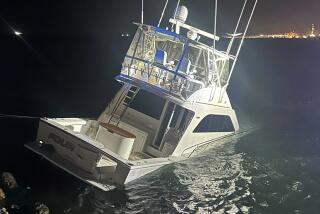4 Sailors’ 118 Days at Sea: Survival Tale or Hoax?
AUCKLAND, New Zealand — Four sailors’ survival at sea for 118 days in an upturned trimaran ranks as one of the world’s greatest survival stories--or one of its greatest hoaxes.
If the tale is to be believed, the trimaran Rose-Noelle was flipped over on June 4 by a huge wave in a 60-knot gale three days out of New Zealand’s South Island. It made land on Sept. 30.
Despite losing up to 40 pounds each, the three New Zealanders and an American survived the stormy southern winter in good shape--such good shape that some people doubt their story.
An official investigation into whether the sailors’ story checks out--and if so, why search and rescue efforts were so far astray--is not expected to be completed for another three weeks.
The investigator has declined comment until his inquiry is completed. But Capt. Melvyn Bowen, who conducted an initial investigation, is convinced that the four are telling the truth.
After visiting the wreckage on isolated Great Barrier Island north of Auckland where the Rose-Noelle drifted ashore, Bowen said he found convincing evidence, such as marine growth on the boat’s topside. “Personally I don’t feel it is a hoax,” he said.
But some questions linger. Local yachtsmen ask why, after such a long time at sea in appalling conditions, the men had no pressure-point or salt sores, which are almost universal for a long sea voyage.
Other points baffling investigators are how two radio messages were supposedly received from the Rose-Noelle by another yacht after the flip and how the Rose-Noelle drifted from 140 miles off the east coast of New Zealand around the top of the island to the west coast.
The pattern of the currents should have taken it farther east toward South America.
Plausible explanations to these mysteries have been suggested and, although skepticism remains, it is hard to imagine a motive for a hoax.
Skipper John Glennie has signed contracts for his story but the payments are hardly likely to compensate for the $145,000 loss of his 40-foot trimaran, which was smashed to bits on rocks.
“All those who think it’s a hoax are bloody idiots,” said crewman Phillip Hofman. Asked if there was any conclusive evidence, he said: “Yeah, the fact that I know we did it and three other people did it.”
The story as they tell it is a remarkable one.
Their 118 days adrift exactly equals the time Maurice and Maralyn Bailey of England spent in a tiny life raft and dinghy after their yacht was pierced by a whale off the Galapagos Islands in 1973.
Other than the undocumented story of a Hong Kong seaman who was reported to have been picked up during World War II after 133 days adrift, it is a record for survival at sea.
Here is their story:
After the boat capsized, they spent their first day trapped in the cabin. Then they hacked a hole in the hull and spent a nightmare four months crammed in a space the size of a double mattress.
For the first month water was desperately short, augmented by soft drinks and meager rations.
But after they rigged a system for collecting rain water, conditions improved and were considerably better, although colder, than those experienced by the Baileys.
Marine growth on the boat attracted more and more fish, and a large grouper even swam into the cabin one day.
“Toward the end we were eating better than you guys at home,” crewman Rick Hellriegel told a news conference on his return.
Glennie dived into the main cabin to retrieve more and more equipment. They had a gas cooker and even rigged up a barbecue on fine days.
But relations were strained. American Jim Nalepka said tension seethed among the four, who barely knew each other before the voyage. He and Hellriegel said they never wanted to see Glennie again. Glennie said the feeling is mutual.
Battles, not physical, were fought over half a biscuit or over who could sit on the well-lit side of the makeshift cabin where reading was possible.
“At one time, one of us, I won’t mention the person, was a liability, but we worked really hard to get that person out of that position. We thought the worst, you know, slitting his throat and pushing him overboard. But we did that in jest,” Nalepka said.
Despite the friction, the four knew they had to depend on each other and gradually jelled into a team. Hellriegel said it was a great help just having the body heat of four people during freezing winter weather.
Five or six times they were forced by the weather to stay below for days on end. That’s when spirits sagged and tensions ran high.
“Cabin fever, we called it. That’s a real condition,” Nalepka said. “Fighting over a half a biscuit seems trivial but no, it was too real. It was classic what we went through.”
More to Read
Sign up for Essential California
The most important California stories and recommendations in your inbox every morning.
You may occasionally receive promotional content from the Los Angeles Times.










